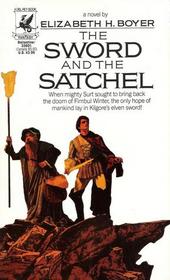 Elizabeth Boyer’s 1980 The Sword and the Satchel, a Scandinavian-mythology fantasy, is a story of a fighter with a magic sword and a wizard with a bag of holding. It has a couple more D&D moves worth pillaging:
Elizabeth Boyer’s 1980 The Sword and the Satchel, a Scandinavian-mythology fantasy, is a story of a fighter with a magic sword and a wizard with a bag of holding. It has a couple more D&D moves worth pillaging:
The frost giants… shouldered their cudgels and passed swiftly, uprooting a few trees for practice. Their glancing eyes filled the air with snow and their breath was like the coldest night in deepest winter.
This is a beautiful detail: just as snow at night is often only visible under streetlights, there are flurries of snow in a frost giant’s cone of vision. It’s also a useful signal for PCs who are trying to sneak by a frost giant and want to know if they’re unseen. Except if it’s actually snowing. Then they’re screwed.
“A real lingorm!” Kilgore puffed. “Do they really get bigger with every bit of gold they have, or is that an old wives’ tale?” “Old wives aren’t so misinformed,” the wizard retorted.
In D&D, there is a correlation between dragon size/HD and treasure size. It would be interesting if there were causation as well. It would make dragons’ greed for treasure make more sense. It would also explain why Smaug freaked out when Bilbo stole that golden cup. That theft made Smaug diminish, just a little. (Maybe the missing cup caused the missing scale over Smaug’s heart?)
If it seems too extreme for all dragons to get this lore, you could give it just to metallic dragons: a silver dragon’s size is based on the amount of silver she has amassed, for instance. In this case, copper dragons would be totally safe. No one wants their hoard of a million copper pieces.
Three horsemen were riding up the side of the barrow toward a flickering blue light at the top. Kilgore strained his eye against the crack to see better, his heart suddenly thudding. From the ancient folklore of his people, he knew a blue light in a barrow mound meant there was treasure inside.
I don’t know enough about Scandinavian folklore – is this a thing? Whether it is or not, it seems cool.
I wouldn’t automatically put a visible blue light in every dungeon. I might turn this into a spell: someone using some sort of Detect Treasure spell might be able to see the blue glow that let them know this dungeon was worth exploring. It might even be a free-to-cast ritual known to all sorts of adventurous people.
Tags: everybook








The dragon/treasure thing amuses me because the idea that dragons grow as their horde does has recently been established as canon in the My Little Pony cartoon!
I really should check out that show.
Alison is planning on blogging about that when she gets back from her honeymoon, I think! Maybe she could do a guest blog where she explains MLP to Paul.
Ooh, that aside on how Smaug’s vulnerability came about is a gem! There’s a cool adventure seed in there – steal something from a monster’s hoard to expose its hidden weakness. It’d work specially well for monsters that are traditionally invulnerable in folklore, such as dragons and special, individual giants in my setting. Thanks!
In D&D, there is a correlation…. (Maybe the missing cup caused the missing scale over Smaug’s heart?)
That’s a very cool idea for a campaign. It would work even better if applied to PCs, explaining tidily their curious fortification building & raiding behaviour.
As far as The Hobbit goes, while Smaug’s weakness is foreshadowed by Bilbo in the line ‘”Every worm has his weak spot,” as my father used to say…’ a couple of pages before his conversation with Smaug, that hardly refutes the hypothesis.
Nicely conceived.
I love the idea of a link between dragon & hoard.
The first thing that comes to mind is that any treasure hoard of sufficient size might spontaneously birth a dragon. For the cautious, this would be good reason to divide ones treasure. For the careless or foolhardy, one might amass a hoard in hopes of spawning a dragon that they would attempt to control.
The second thing that comes to mind is that you can play up a dragon as an embodiment of greed or lust.